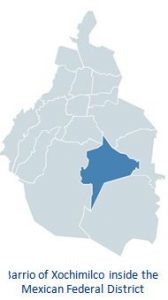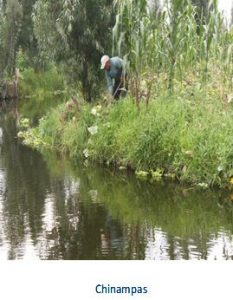By Manzanillo Sun Writer From the September 2016 Edition
Xochimilco is one of the 16 delegaciones or boroughs within Mexican Federal District. The borough is centered on the formerly independent city of Xochimilco, which was established on what was the southern shore of Lake Xochimilco in the pre-Hispanic period.
Today, the borough consists of the eighteen “barrios” or neighborhoods of this city along with fourteen  “pueblos” or villages that surround it, covering an area of 125 km2 (48 square miles).
“pueblos” or villages that surround it, covering an area of 125 km2 (48 square miles).
While the borough is somewhat in the geographic center of the Federal District, it is considered to be “south” and has an identity separate from the historic center of Mexico City. This is due to its historic separation from that city during most of its history.
Xochimilco is best known for its canals, which are left from what was an extensive lake and canal system that connected most of the settlements of the Valley of Mexico.
These canals, along with artificial islands called chinampas, at-tract tourists and other city residents to ride on colorful gon-dola-like boats called “trajineras” around the 170 km (110 mi) of canals. This canal and chinampa system, as a vestige of the area’s pre-Hispanic past, has made Xochimilco a World Heritage Site.
The borough of Xochimilco was created in 1928, when the federal government reorganized the Federal District of Mexico City into sixteen boroughs. The Xochimilco borough was centered on what was the city of Xochimilco, which had been an independent settlement from the preHispanic period to the 20th century.
The area’s historic separation from Mexico City proper remains in its culture. While officially part of the city, its identity is more like a suburb.
 Even though the original town is in the geographic center of the Federal District, it is still considered to be “south.” This historic center was designated as a “Barrio Mágico” by the city in 2011. The borough has an emblem, also known as an Aztec glyph, which is a representation of the area’s spongy soil from which two flowering plants emerge.
Even though the original town is in the geographic center of the Federal District, it is still considered to be “south.” This historic center was designated as a “Barrio Mágico” by the city in 2011. The borough has an emblem, also known as an Aztec glyph, which is a representation of the area’s spongy soil from which two flowering plants emerge.
Xochimilco is characterized by a system of canals, which measure about a total of 170 km2. These canals, and the small colorful boats that float on them among artificially created land called chinampas are internationally famous. These canals are popular with Mexico City residents as well, especially on Sun-days. These canals are all of what is left of what used to be a vast lake and canal system that extended over most parts of the Valley of Mexico, restricting cities such as Tenochtitlan (Mexico City) and Xochimilco to small islands.
This system of water ways was the main transportation venue, especially for goods from the pre-Hispanic period until the 20th century. In the pre-Hispanic period, parts of the shallow lakes Chinampas were filled in, creating canals. Starting in the early colonial period, the interconnected lakes of the valley, including Lake Xochimilco, were drained.
By the 20th century, the lakes had shrunk to a system of canals that still connected Xochimilco with the center of Mexico City.
However, with the pumping of underground aquifers since the early 20th century, water tables have dropped, drying canals, and all that are left are the ones in Xochimilco. The canals are fed by fresh water springs, which is artificially supplemented by treated water. This because water tables are still dropping and human expansion and filling in of canals is still occurring, threatening to have the last of these canals disappear despite their importance to tourism.
drying canals, and all that are left are the ones in Xochimilco. The canals are fed by fresh water springs, which is artificially supplemented by treated water. This because water tables are still dropping and human expansion and filling in of canals is still occurring, threatening to have the last of these canals disappear despite their importance to tourism.
These remaining canals and their ecosystem was declared a World Heritage Site in 1987, with the purpose of saving them. An important part of this ecosystem is a juniper tree called a “ahuejote” that is native to the shallow waters of the lake/canals. These stem erosion, act as wind breakers and favor the reproduction of a variety of aquatic species. Some of these endemic species include a freshwater crayfish called an acocil, and the Montezuma frog. However, the most representative animal from these waters is the axolotl (Ambystoma mexicanum).
Download the full edition or view it online
Manzanillo Sun’s eMagazine written by local authors about living in Manzanillo and Mexico, since 2009



